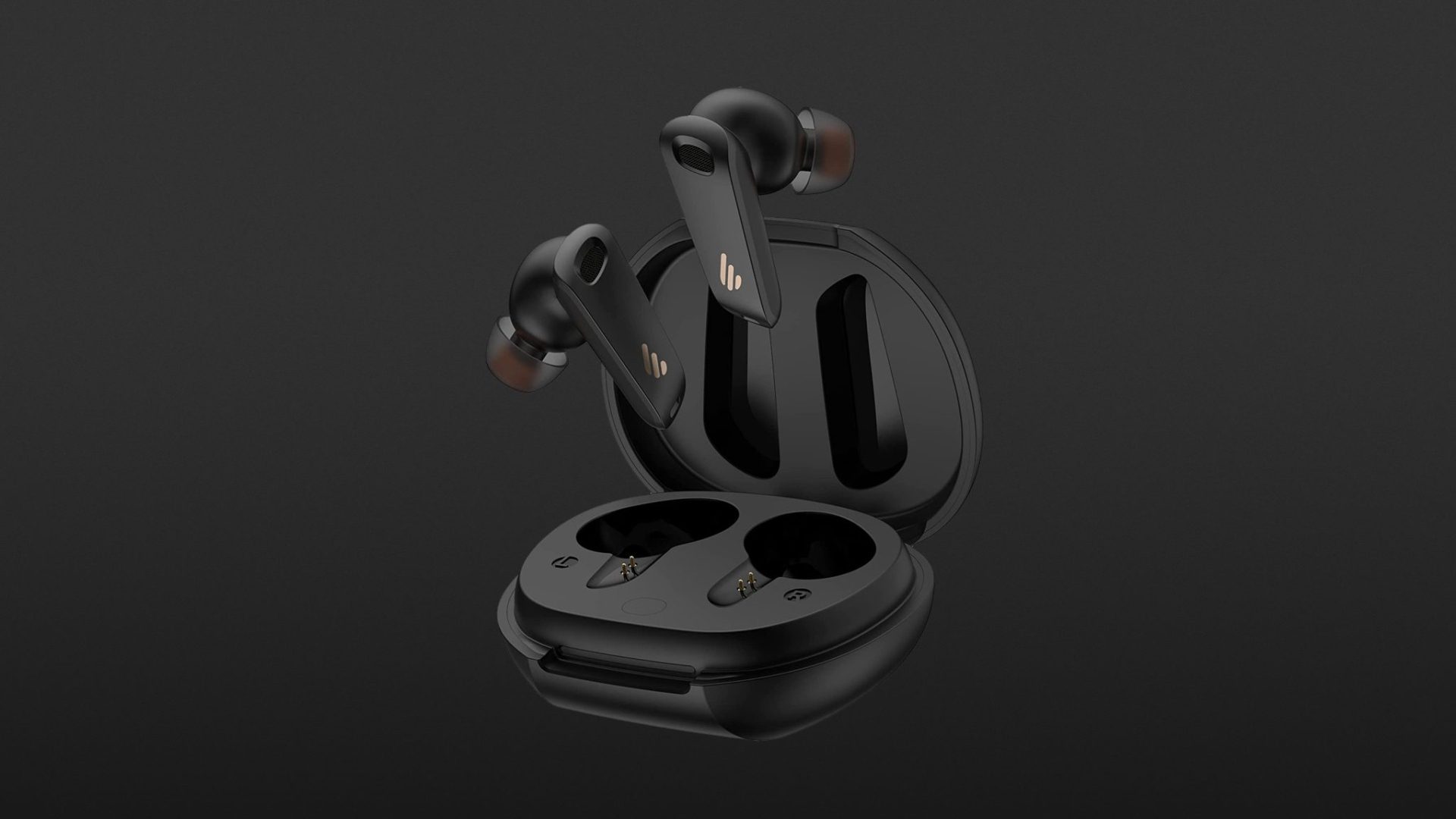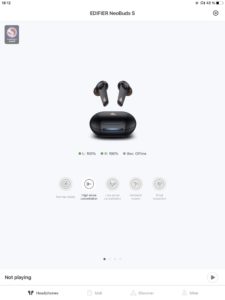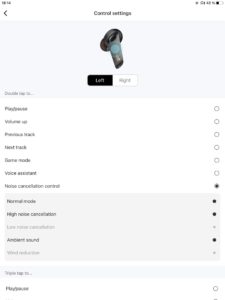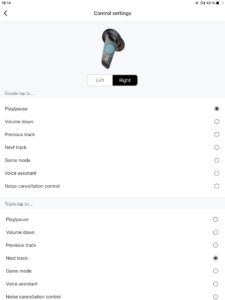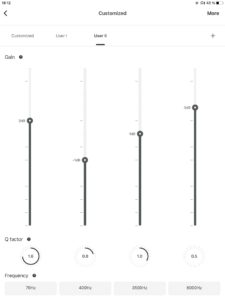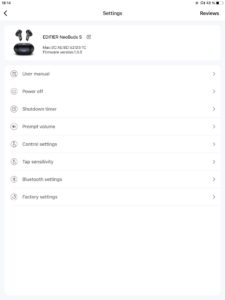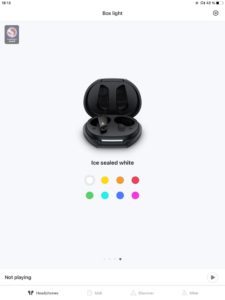If you own a Snapdragon smartphone and are looking for compatible True Wireless in-ears, then you should definitely take a closer look at the Edifier NeoBuds S (RRP 179 euros). These weatherproof earphones should also appeal to other interested parties thanks to their comfortable, long-term fit, support for aptX Adaptive, and thoroughly successful ambient noise control. The suppression of wind noise during phone calls also scores points, although, unfortunately, this does not apply to louder background noises. Furthermore, there is no facility for multipoint connections, and the touch control appears to be in need of improvement due to its limited range of functions.
- Comfortable fit
- Dust and water resistant according to IP54
- Fast charging function
- App connection with ambient noise control and sound adjustment
- Speech intelligibility when talking on the phone (except in a louder environment)
- Support aptX Adaptive and aptX
- No multipoint connections
- Rather cumbersome activation of the gaming mode
- Touch control can be improved
- No manual switching on and off of the in-ears possible
Thanks to the latest technologies from Qualcomm Snapdragon Sound (QSS), the Edifier NeoBuds S are said to offer HiRes audio via Bluetooth, low latency and crisp voice clarity during phone calls. Noise cancelling and ambient mode can also be used to attenuate or amplify outside noise via these wireless in-ears, while app connectivity provides earpiece and sound settings.
The Edifier NeoBuds S comes with a choice of seven ear tips in different sizes, which allows these in-ears to be customised and contributes to a high level of wearing comfort. These earphones remain comfortable to wear even during listening sessions lasting several hours, shield clearly from the outside world and have a stable fit. The system should not be exposed to strong vibrations, but otherwise, nothing stands in the way of sporting activities, especially as these in-ears are made to be dust- and water-resistant according to IP54.
Battery life
In terms of power, the Edifier NeoBuds S offer a runtime of six hours and ten minutes at a slightly raised volume level in basic mode. If the noise cancellation is permanently active, five and a half hours per charge is achievable. In their case, these earphones can also be fully charged twice and charged to 65 per cent once, which results in a total runtime of a good 23 hours in standard mode and 21 hours in ANC mode. One charging process takes 55 minutes, but this is not visible from the outside, as these in-ears do not have a charge indicator. However, if you are in a hurry, you can use the quick-charge function, which provides capacity for just under 90 minutes after ten minutes of power supply. The battery reserve in the case can also be restored in 75 minutes via the included USB-C to USB-A charging cable.
Operation
When getting started, pairing the Edifier NeoBuds S, which supports Bluetooth standard 5.2, can be done directly by opening the case. This turns the system on and automatically puts it into pairing mode. If other devices are to be paired, however, the pairing mode must be activated manually, and this seems somewhat awkward. It is done either by pressing and holding the case button while the in-ears are in the charger or via the app. Multipoint connections with two devices, such as a smartphone and tablet or laptop at the same time, are not provided. Another drawback is that the in-ears cannot be switched on and off manually via touch-sensitive surfaces; this means that the case has to be carried around all the time.
Once a wireless connection is established, a double tap on the right side controls playback in the factory settings, while the left side can be switched between ANC and ambient mode. A double tap on either side also allows you to answer a phone call. In addition, a triple tap on the right headphone is used to skip forward in track selection, while the left side can be used to activate or deactivate gaming mode. Unfortunately, the remote does not offer more control options, so there is room for improvement here, as additional functions could be implemented, for example, by holding it down. However, the assignment of controls can be adapted to one’s own needs via an app, which is a well-implemented feature. The sensitivity of the touch surfaces can also be adjusted.
App connection
In addition to the ability to configure the NeoBuds S’s touch controls, the Edifier Connect app (Android and iOS) provides a battery level indicator for the earpieces as well as the case and ambient noise control. In addition to the standard operation with “High” and “Low”, this includes two noise reduction options, a special algorithm for wind noise and a transparency mode. For sound adjustment, there are two pre-configured settings, “Classic” and “Dynamic”, as well as an EQ for custom settings that can be saved as pre-sets and shared with friends. The gaming mode can also be activated or deactivated via the app, and the case lights can be changed from white to yellow, orange, red, green, turquoise, blue or pink. A timer and volume control are available, as well as the option to perform firmware updates.
Speech intelligibility when making phone calls
The Edifier NeoBuds S use six microphones (three per side) and Qualcomm aptX Voice technology to deliver high voice quality when making calls, and they do this flawlessly in a quiet environment. Wind noise is also filtered effectively, and the intelligibility of one’s own voice is hardly impaired. However, this works less convincingly in a busy background environment, as the attenuation of complex ambient noises is subject to fluctuations and is more subtle, which affects speech intelligibility in a louder environment.
Gaming mode
With aptX Adaptive, the Edifier NeoBuds S supports a low-latency audio codec. If this is not available on your player device, the gaming mode is also intended to ensure that there is no noticeable offset between picture and sound when playing mobile and computer games or watching films. The synchronisation also improves considerably when using the SBC codec. However, after activating the latency reduction, these in-ears must first be disconnected and reconnected in order to benefit from the optimisation. This problem is solved better by some competitors in that the earphones automatically reconnect when the gaming mode is switched on. We also noticed that the latency reduction has a negative effect on Bluetooth stability and range. While several rooms and a distance of up to 15 metres could be bridged in standard mode, dropouts started to happen after seven to eight metres when in gaming mode, which is why we wouldn’t recommend the latency optimisation for general use.
Noise Cancellation and Transparency Mode
The Edifier NeoBuds S’s noise cancelling effectively attenuates ambient noise. Voices remain perceptible, but they move noticeably into the background. The difference between the two types of ANC seems rather marginal. However, the “High” setting offers advantages for keyboard noises, while voices seem a little brighter than in the “Low” mode. In the ambient mode, there is also clear amplification of external noises, which is intense enough that the environment is not blocked out even at a higher volume, and there is responsiveness up to medium playback levels. A conversation can be held without any problems while playback is paused, especially as other people can still be understood over a distance of several metres. In transparency mode, however, perceptible background noise has to be tolerated.
Sound
In Classic mode, the Edifier NeoBuds S surprised us with a powerful bass response that seemed tight and controlled, although not exactly lean, as there was some fullness. This was accompanied by a present, detailed mid-range that presented voices with a high level of intelligibility, which means that this set-up is also recommended for movies, podcasts or audiobooks. Sibilant sounds were reproduced unobtrusively and discreetly, while the upper registers were quite restrained. As a result, the high-frequency range could be considered to be extremely well-behaved but, at the same time, somewhat dull and lifeless.
By contrast, Dynamic mode aims to provide listening fun from modern music styles and action-packed games or films, and it makes full use of the advantages of a hybrid system that consists of a balanced armature and a dynamic 10mm driver. An extended low bass with increased substance ensures a rich reproduction in the lower registers. As a counterpart, the high frequencies gain a lot of energy, appearing much more lively and agile than in Classic mode, while the warm midrange blends harmoniously into the overall structure.
In addition to the Classic and Dynamic modes, the Customised setting provides a starting point for custom sound adjustments. Respectable results can be achieved with the EQ settings, even if the options are limited to four bands. Therefore, an update that creates more freedom for sound personalisation by increasing the number of bands would be desirable.
Technical specifications
- Ear couplingIn-ear
- Typeclosed
- Transducer principledynamic + Balanced Armature
- Frequency response (headphones)20 - 40.000 Hz
- Impedance24 ohms
- Sound pressure level (SPL)92 ± 3 dB
- Weight without cable6 g each, case 48 g
What's in the box
- 7 pairs of ear tips (XXS/XS/S/M/L/XL/XXL)
- USB-C to USB-A charging cable
- Carrying pouch
- Charging case
Special features
- Available in black and white
- BT codecs: SBC, aptX, aptX Adaptive
- BT version: 5.2
- BT profiles: A2DP, AVRCP, HFP



